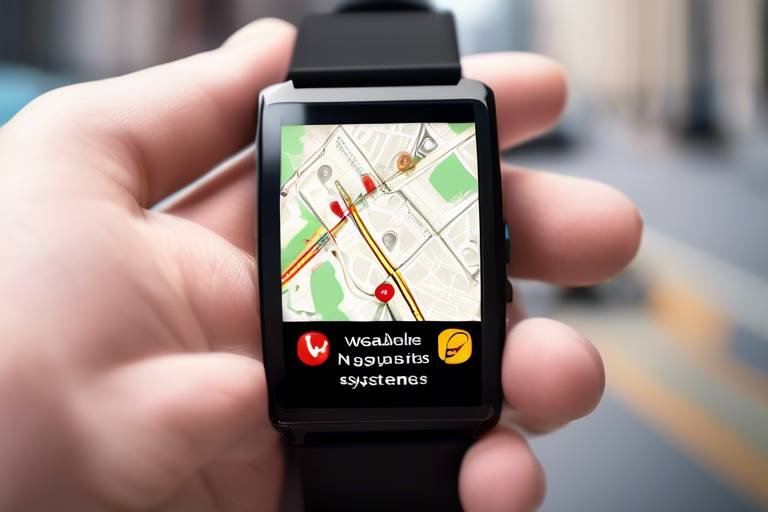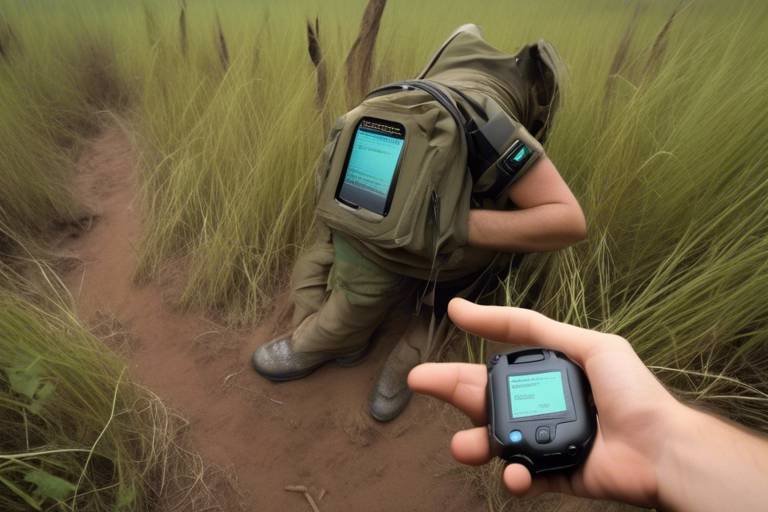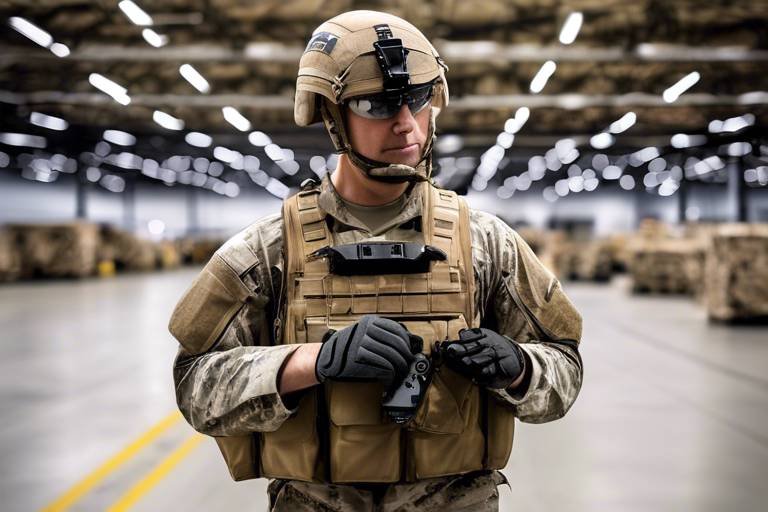How Smart Wearables Enhance Situational Awareness
In a world that’s constantly buzzing with activity and information, situational awareness has become a vital skill for navigating our daily lives. Whether you're walking through a crowded street, managing a busy workplace, or responding to an emergency, being aware of your surroundings can make all the difference. Enter smart wearables—those nifty gadgets we often see strapped to wrists or tucked into pockets. These devices do more than just tell time or count steps; they are revolutionizing how we perceive and interact with our environment.
Imagine having a personal assistant that not only tracks your fitness goals but also alerts you to potential dangers, monitors your health, and helps you navigate through unfamiliar places. Smart wearables, such as smartwatches and fitness trackers, are designed to enhance our situational awareness in numerous ways. They provide real-time data, notifications, and insights that keep us informed and ready to react. In this article, we’ll delve into how these devices are shaping our understanding of situational awareness and how they can be leveraged across various settings.
As we explore the role of smart wearables, it's essential to understand what situational awareness truly means. At its core, situational awareness is about perceiving environmental elements, comprehending their significance, and projecting future states. This skill is crucial for effective decision-making, whether you're an athlete, a first responder, or simply someone trying to stay safe in a busy city. The ability to assess your surroundings quickly and accurately can help you avoid accidents, make informed choices, and even save lives.
With the rise of smart wearables, we are witnessing a transformation in how we gather and process information. These devices have evolved significantly over the past few years, incorporating advanced technologies like GPS, sensors, and connectivity features. They seamlessly integrate into our daily routines, making it easier than ever to stay connected to our health and environment. In the following sections, we will explore the various types of smart wearables, their applications in different fields, and the myriad benefits they offer in enhancing our situational awareness.
So, how do these smart devices truly work their magic? They operate on a simple premise: by collecting data from our surroundings and presenting it in a user-friendly format. This can include everything from heart rate monitoring to location tracking. The data collected is not just numbers; it’s actionable information that can lead to better decisions. For instance, if a fitness tracker detects an unusual spike in your heart rate, it can prompt you to take a break or seek medical attention. Similarly, a GPS-enabled device can guide you through a new city while alerting you to potential hazards along the way.
In summary, smart wearables are more than just trendy gadgets; they are powerful tools that enhance our situational awareness, improve our safety, and streamline our daily activities. As we continue to explore their impact across various sectors, one thing is clear: embracing this technology can lead to a more informed, connected, and secure life.
- What are smart wearables? Smart wearables are electronic devices worn on the body that track and analyze various metrics, such as health data, location, and environmental conditions.
- How do smart wearables enhance situational awareness? They provide real-time data and alerts that help users make informed decisions based on their surroundings.
- What types of smart wearables are available? Common types include smartwatches, fitness trackers, augmented reality glasses, and health monitoring devices.
- Can smart wearables improve personal safety? Yes, features like emergency alerts and location tracking significantly enhance personal safety in various situations.
- Are smart wearables useful in workplaces? Absolutely! They can monitor worker health, streamline communication, and reduce accidents in hazardous environments.
Understanding Situational Awareness
Situational awareness is more than just a buzzword; it’s a critical skill that affects our daily lives and professional environments. Imagine walking through a crowded street or navigating a busy workplace—having a keen sense of what’s happening around you can mean the difference between safety and danger. In essence, situational awareness refers to the perception of environmental elements and events, which is crucial for making informed decisions. Whether you're a firefighter rushing into a burning building or a parent watching over your children at a park, your ability to assess and respond to your surroundings can significantly impact outcomes.
In everyday life, situational awareness allows individuals to recognize potential hazards, respond to emergencies, and make quick decisions that can safeguard their well-being. For instance, when driving, being aware of other vehicles, pedestrians, and road conditions can prevent accidents. In professional settings, especially in high-stakes environments like healthcare or aviation, situational awareness is paramount. It involves not just recognizing immediate threats but also understanding the broader context—like anticipating how a patient might react to treatment or how weather conditions could affect flight safety.
Furthermore, situational awareness can be broken down into three key components:
- Perception: Recognizing the elements in your environment, such as people, objects, and events.
- Comprehension: Understanding the meaning of those elements and how they relate to one another.
- Projection: Anticipating future events based on current information.
These components work together to create a comprehensive understanding of one’s surroundings. For example, a security guard at a mall must not only observe the crowd but also comprehend the dynamics of the situation—like identifying suspicious behavior or understanding the layout of the building. By projecting possible scenarios, the guard can take proactive measures to prevent incidents before they escalate.
In summary, situational awareness is a vital competency that enhances decision-making and safety across various contexts. It empowers individuals to navigate their environments with confidence and agility, ultimately leading to improved outcomes in both personal and professional realms. As we delve deeper into the role of smart wearables in enhancing situational awareness, it becomes clear that these devices are not just gadgets; they are essential tools that can help us stay connected, informed, and safe in an ever-changing world.
The Rise of Smart Wearables
The world is buzzing with the rise of smart wearables, and it’s hard to ignore their growing presence in our daily lives. From the moment we wake up to the time we hit the sack, these nifty gadgets are not just accessories; they are becoming essential tools that enhance our situational awareness. But what exactly are smart wearables? Well, they are devices that you can wear, often on your wrist or body, which connect to your smartphone or the internet to provide real-time data and notifications. Imagine having a personal assistant on your wrist, ready to alert you about your health, location, or even the weather!
Over the past decade, smart wearables have evolved from simple pedometers to sophisticated devices that can track everything from your heart rate to your sleep patterns. The technology embedded in these wearables has made significant leaps forward, integrating features like GPS, health monitoring sensors, and even augmented reality. For instance, many smartwatches today not only tell time but also monitor your stress levels, remind you to breathe, and even alert you if your heart rate goes above or below a certain threshold. This evolution is not just about health; it’s about creating a seamless connection between technology and everyday life.
One of the most exciting aspects of smart wearables is their ability to integrate seamlessly into our routines. They serve as a bridge between our physical activities and the digital world, allowing us to stay connected without being glued to our phones. Imagine going for a jog and receiving a notification about an important meeting or a message from a loved one—all without needing to pull out your phone. This integration has made it easier for people to manage their time and stay informed, which is crucial in today’s fast-paced environment.
As we look at the landscape of smart wearables, it’s important to recognize the different types available. They can be broadly categorized into several categories, including:
- Health Monitoring Devices: These include fitness trackers and smartwatches that monitor heart rate, sleep quality, and physical activity.
- GPS Trackers: Devices that provide real-time location data, useful for outdoor activities and personal safety.
- Augmented Reality Glasses: Wearables that overlay digital information onto the real world, enhancing situational awareness.
This variety means there’s a smart wearable for almost everyone, whether you’re a fitness enthusiast, a busy professional, or someone who wants to stay connected while on the go. The potential applications are endless, and as technology continues to advance, we can expect even more innovative features that will further enhance our situational awareness.
In summary, the rise of smart wearables is not just a trend; it’s a revolution in how we interact with our environment and manage our lives. These devices are transforming the way we perceive and respond to the world around us, making it easier to stay informed, healthy, and connected. As we embrace this technology, the possibilities for enhancing our situational awareness are truly exciting!
Types of Smart Wearables
Smart wearables have transformed the way we interact with technology and perceive our surroundings. They come in various forms, each designed to enhance our situational awareness in different aspects of life. From health monitoring to navigation, these devices serve unique purposes that cater to individual needs and preferences. Understanding the different types of smart wearables can help you choose the right device for your lifestyle.
One of the most prevalent categories of smart wearables is health monitoring devices. These gadgets, such as fitness trackers and smartwatches, are equipped with sensors that track vital signs like heart rate, blood pressure, and even sleep patterns. By providing real-time feedback, they empower users to take charge of their health and make informed decisions. For instance, a fitness tracker may alert you if your heart rate exceeds a safe threshold during a workout, prompting you to slow down and prevent potential health risks.
Another exciting category is GPS and navigation tools. These wearables are designed to enhance your location awareness, making them invaluable for outdoor enthusiasts and urban dwellers alike. Imagine hiking in a dense forest or navigating through a bustling city; GPS-enabled devices can guide you with turn-by-turn directions, ensuring you stay on the right path. Furthermore, in emergency situations, these devices can share your location with first responders, potentially saving your life. The integration of GPS technology into wearables has truly revolutionized how we explore and interact with our environments.
Additionally, we have augmented reality glasses, which are at the forefront of merging the physical and digital worlds. These innovative devices allow users to overlay digital information onto their real-world surroundings, enhancing situational awareness in various contexts. For example, a construction worker wearing augmented reality glasses can access blueprints and safety protocols while keeping their hands free to work. This seamless integration of information helps improve efficiency and safety on the job.
In summary, the types of smart wearables available today are diverse and cater to different needs. Health monitoring devices keep us informed about our physical well-being, GPS tools enhance our navigation skills, and augmented reality glasses provide a unique perspective on our surroundings. As technology continues to evolve, we can expect even more exciting developments in the world of smart wearables, making them an essential part of our daily lives.
Health Monitoring Devices
In the realm of smart wearables, stand out as a game-changer. These innovative gadgets are not just trendy accessories; they are powerful tools that provide real-time data on vital signs and physical activity. Imagine having a personal health assistant right on your wrist, constantly keeping tabs on your well-being. These devices can track a plethora of metrics, including heart rate, sleep patterns, calorie burn, and even blood oxygen levels. This constant stream of information empowers users to make informed decisions about their health.
But how do these devices actually enhance our health awareness? For starters, they foster a proactive approach to health management. Rather than waiting for annual check-ups or feeling unwell, users can monitor their health daily. This can lead to early detection of potential issues, allowing for timely interventions. For instance, if a user notices a consistent increase in their heart rate during periods of rest, it may prompt them to consult a healthcare professional. It's like having a miniature doctor that nudges you to pay attention to your body.
Moreover, the integration of these devices with mobile applications takes health monitoring a step further. Many wearables sync with apps that analyze the collected data, providing users with insights and trends over time. This allows for a more comprehensive understanding of one’s health. For example, a user might discover that their sleep quality improves on days when they engage in regular physical activity, leading to better lifestyle choices.
Let's take a closer look at some of the key features of health monitoring devices:
| Feature | Description |
|---|---|
| Heart Rate Monitoring | Tracks your heart rate in real-time, helping you understand your cardiovascular health. |
| Sleep Tracking | Monitors sleep patterns and quality, providing insights for better rest. |
| Activity Tracking | Counts steps, calories burned, and active minutes to encourage a more active lifestyle. |
| Health Alerts | Sends notifications for irregular heart rates or other health concerns. |
In addition, many devices come equipped with features that can alert users to potential health emergencies. For instance, if a device detects a fall, it can automatically send an alert to emergency contacts. This is particularly beneficial for elderly users or those with chronic health conditions, as it adds an extra layer of safety. The peace of mind that comes from knowing help is just a notification away is invaluable.
Furthermore, the social aspect of health monitoring cannot be overlooked. Many devices allow users to share their progress with friends or family, creating a supportive community around health and fitness goals. This social encouragement can motivate individuals to stay on track and achieve their health objectives.
In summary, health monitoring devices are revolutionizing how we approach personal health. They provide essential insights, promote proactive management, and enhance our overall awareness of well-being. As technology continues to evolve, we can expect even more sophisticated features that will further empower individuals to take charge of their health like never before.
- What types of health metrics can smart wearables track? Most health monitoring devices can track heart rate, sleep patterns, steps taken, calories burned, and some can even monitor blood oxygen levels and stress levels.
- Are health monitoring devices accurate? While they are generally reliable, it's important to remember that these devices are not substitutes for professional medical equipment. They provide estimates and trends rather than precise measurements.
- Can health monitoring devices help with chronic conditions? Yes, many devices are designed to help users with chronic conditions by providing continuous monitoring and alerts that can prompt timely medical attention.
- How do I choose the right health monitoring device? Consider your specific health goals, the metrics you want to track, and any additional features that may be important to you, such as GPS or smartphone integration.
GPS and Navigation Tools
In today's fast-paced world, having a reliable sense of direction is more important than ever. This is where come into play, particularly in the realm of smart wearables. Imagine strapping on a device that not only tells you where you are but also guides you to your destination with real-time updates. These tools are not just about convenience; they significantly enhance situational awareness by providing critical location data at a glance.
Smart wearables equipped with GPS technology are revolutionizing how we navigate our environments. From fitness trackers that monitor your running route to smartwatches that help you find your way in unfamiliar cities, these devices are designed to keep you informed and safe. For instance, when you’re out for a jog, a fitness tracker can map your route and track your distance, allowing you to focus on your workout without worrying about getting lost. This capability is especially beneficial in urban settings, where streets can be confusing and navigation apps can drain your phone's battery.
Moreover, GPS-enabled wearables have proven invaluable in emergency situations. Imagine you’re hiking in a remote area and suddenly lose your way. A wearable device with GPS can not only help you find your way back but can also alert emergency services if you're in distress. This feature is a game-changer, as it provides an extra layer of safety, particularly for outdoor enthusiasts and those working in hazardous environments.
In addition to personal safety, GPS tools can enhance situational awareness in various professional fields. For example, in the logistics sector, delivery drivers equipped with GPS wearables can receive real-time traffic updates, rerouting them to avoid congested areas and ensuring timely deliveries. This not only improves efficiency but also enhances the overall safety of the operation.
Here are some key benefits of GPS and navigation tools in smart wearables:
- Real-time Tracking: Users can monitor their location continuously, which is crucial for safety and navigation.
- Route Optimization: Smart wearables can suggest the fastest routes, saving time and reducing stress.
- Emergency Alerts: In case of an emergency, these devices can send out distress signals along with location information.
In conclusion, GPS and navigation tools in smart wearables are not just trendy gadgets; they are essential tools that enhance situational awareness, ensuring that users can navigate their environments safely and efficiently. Whether you're an athlete, a busy professional, or someone who loves exploring the great outdoors, these devices are designed to keep you informed and secure, making every journey a little less daunting.
Applications in Various Fields
Smart wearables are not just trendy gadgets; they are transforming how we interact with our environments across various fields. From healthcare to emergency services, their applications are revolutionizing situational awareness and enhancing efficiency. For instance, in the healthcare sector, wearables like heart rate monitors and glucose trackers empower patients and doctors alike by providing real-time data. This data can lead to quicker diagnoses and more personalized treatment plans, ultimately improving patient outcomes.
In emergency services, smart wearables play a critical role in ensuring the safety of first responders. Imagine a firefighter equipped with a smart helmet that not only provides real-time communication but also monitors vital signs and environmental conditions. This technology allows for rapid decision-making in high-stress situations, potentially saving lives. The integration of augmented reality (AR) in these wearables can also provide crucial information about building layouts or hazardous materials, enhancing situational awareness in emergencies.
Moreover, the corporate world is tapping into the benefits of smart wearables to boost workplace safety and productivity. For example, companies are implementing smart safety vests that monitor workers' health metrics and environmental hazards. This proactive approach to employee safety can significantly reduce workplace accidents. According to recent studies, organizations that have embraced smart wearables have reported a 30% decrease in workplace incidents within the first year of implementation.
Here’s a brief overview of how smart wearables are being utilized in different fields:
| Field | Application | Benefits |
|---|---|---|
| Healthcare | Monitoring vital signs | Improved patient outcomes |
| Emergency Services | Real-time data for first responders | Enhanced safety and quick decision-making |
| Corporate Sector | Health monitoring and safety tracking | Reduced accidents and increased productivity |
In addition to these fields, smart wearables are finding their way into education, sports, and even personal safety. Students can use wearables to track their physical activity, while athletes can monitor their performance metrics to optimize training. Personal safety devices, such as smart jewelry or keychains, can alert authorities in emergencies, providing peace of mind to users. The versatility of smart wearables is one of their most appealing features, making them applicable in virtually any field where situational awareness is key.
As technology continues to evolve, we can expect even more innovative applications of smart wearables. The potential for these devices to enhance situational awareness is enormous, and as they become more integrated into our daily lives, they will undoubtedly change the way we interact with the world around us.
- What are smart wearables? Smart wearables are electronic devices worn on the body that can track various metrics and provide real-time data for improved situational awareness.
- How do smart wearables enhance safety? They provide features like health monitoring, emergency alerts, and location tracking, which can help individuals stay safe in various situations.
- Can smart wearables be used in professional settings? Yes, they are widely used in healthcare, emergency services, and corporate environments to improve efficiency and safety.
- What are some examples of smart wearables? Examples include smartwatches, fitness trackers, health monitors, and augmented reality glasses.
Benefits of Enhanced Situational Awareness
In today's fast-paced world, the ability to stay aware of our surroundings has become more crucial than ever. Enhanced situational awareness through smart wearables offers a myriad of benefits that can significantly improve both personal and organizational outcomes. Imagine walking through a crowded city street, your smartwatch buzzing gently on your wrist, alerting you to an approaching vehicle or a potential hazard. This is just one example of how these devices can elevate our awareness and decision-making capabilities.
When we talk about enhanced situational awareness, we are essentially referring to a heightened perception of what is happening around us. This awareness can lead to better decision-making, which is invaluable in both personal and professional settings. For individuals, it means being more attuned to safety risks and health indicators, while for organizations, it translates into improved operational efficiency and reduced risks. The integration of smart wearables into our daily lives provides real-time data that empowers us to act swiftly and effectively.
Consider the following key benefits that smart wearables bring to the table:
- Improved Decision-Making: With immediate access to critical data, users can make informed choices quickly, whether it's responding to a health alert or navigating through a busy area.
- Enhanced Safety: Features like emergency alerts and location tracking ensure that individuals can maintain their safety, especially in unfamiliar or high-risk environments.
- Health Monitoring: Continuous monitoring of vital signs enables proactive health management, allowing users to detect potential health issues before they escalate.
- Increased Efficiency: In workplaces, smart wearables can streamline communication and improve workflow, ultimately leading to higher productivity.
Moreover, the benefits extend beyond individuals to organizations that adopt smart wearable technology. For instance, in industries such as construction or healthcare, the ability to monitor worker health and safety in real-time can drastically reduce the number of workplace accidents. A study revealed that companies using wearable technology saw a 30% reduction in workplace injuries. This not only protects employees but also saves companies money in insurance claims and lost productivity.
To illustrate the impact of enhanced situational awareness, let's take a look at a simple comparison of traditional methods versus smart wearable technology:
| Aspect | Traditional Methods | Smart Wearable Technology |
|---|---|---|
| Reaction Time | Delayed response due to manual checks | Instant alerts and notifications |
| Data Collection | Periodic assessments | Continuous real-time monitoring |
| Health Management | Reactive approach | Proactive health insights |
| Safety Measures | Manual safety checks | Automated alerts for hazards |
As we can see, the shift from traditional to smart wearable technology not only enhances situational awareness but also transforms how we approach safety and efficiency. By leveraging the power of real-time data and immediate notifications, individuals and organizations can navigate their environments with a greater sense of confidence and security.
In conclusion, the benefits of enhanced situational awareness through smart wearables are profound and far-reaching. From personal safety enhancements to workplace efficiency, these devices are changing the way we interact with our surroundings. As technology continues to evolve, we can only expect these benefits to grow, making our lives safer and more productive.
- What are smart wearables?
Smart wearables are electronic devices worn on the body that collect and transmit data, helping users monitor various aspects of their health and environment. - How can smart wearables improve personal safety?
They can provide features like emergency alerts, location tracking, and health monitoring, which enhance individual security in various situations. - What industries benefit from smart wearables?
Industries such as healthcare, construction, and emergency services see significant benefits from the use of smart wearables in enhancing situational awareness and safety. - Are smart wearables only for health monitoring?
No, while health monitoring is a significant application, smart wearables also enhance navigation, communication, and overall situational awareness.
Personal Safety Enhancements
When it comes to personal safety, smart wearables are like having a superhero sidekick right on your wrist. These devices are not just trendy gadgets; they are equipped with a plethora of features designed to keep you safe and informed in real-time. Imagine walking alone at night and having the ability to send an emergency alert to your loved ones with just a tap. This is the kind of peace of mind that smart wearables bring to our daily lives.
One of the standout features of many smart wearables is their emergency alert system. With a simple press of a button, users can notify emergency contacts or even local authorities, providing them with crucial information such as location and health status. This can be a game-changer in situations where every second counts. For instance, if someone feels threatened or is in distress, they can discreetly send out a signal without drawing attention to themselves, allowing for a faster response from those who can help.
Moreover, smart wearables often come equipped with location tracking capabilities. This is particularly useful for parents keeping tabs on their children or for individuals who frequently venture into unfamiliar areas. The ability to track someone’s location in real-time can significantly reduce the anxiety associated with safety. For example, if a child is out playing, parents can easily check their whereabouts through an app linked to their child’s smartwatch. This feature not only enhances safety but also fosters trust between parents and children.
Another critical aspect of personal safety is health monitoring. Many smart wearables can track vital signs like heart rate, blood oxygen levels, and even detect falls. This is especially beneficial for the elderly or those with health conditions. In the event of an emergency, these devices can automatically alert healthcare providers or emergency contacts if they detect something abnormal. This proactive approach to health can prevent serious situations before they escalate.
In addition to these features, smart wearables often integrate seamlessly with other safety apps, creating a comprehensive safety network. For instance, some devices can sync with personal safety apps that provide additional resources like nearby emergency services, safety tips, and community alerts. This interconnectedness enhances situational awareness, allowing users to react swiftly to any potential threats.
Ultimately, the integration of technology into personal safety through smart wearables is not just a trend; it's a revolution. These devices empower individuals to take control of their safety in ways that were previously unimaginable. By combining emergency alerts, location tracking, and health monitoring, smart wearables serve as a vital tool for enhancing personal safety, making them indispensable in today’s fast-paced world.
- What are smart wearables? Smart wearables are devices like smartwatches and fitness trackers that incorporate technology to monitor health, provide navigation, and enhance personal safety.
- How do emergency alerts work on smart wearables? Most smart wearables have a dedicated button that, when pressed, sends an alert to pre-selected contacts or emergency services, often including GPS location.
- Can smart wearables track my location? Yes, many smart wearables come with GPS capabilities, allowing users to track their location or share it with others for safety purposes.
- Are health monitoring features reliable? While smart wearables provide valuable data, they should not replace professional medical advice. They are best used for general health awareness.
Workplace Efficiency and Safety
In today's fast-paced work environment, efficiency and safety are more crucial than ever. Smart wearables are stepping up to the plate, transforming how we approach these two vital aspects. Imagine a world where your health is monitored in real-time, where communication flows seamlessly, and where accidents are significantly reduced. This is not just a dream; it’s the reality that smart wearables are creating in workplaces across the globe.
One of the standout features of smart wearables is their ability to monitor worker health continuously. Devices like smart helmets and fitness trackers can track vital signs, alerting workers and supervisors to any potential health issues before they escalate. For instance, if a worker’s heart rate spikes unexpectedly, the system can send an alert, allowing for immediate intervention. This proactive approach not only enhances individual safety but also contributes to a healthier workforce overall.
Moreover, communication is key in any workplace, especially in high-risk environments. Smart wearables can facilitate instant communication among team members, ensuring everyone is on the same page. For example, a construction worker wearing a smart helmet can receive real-time updates about site conditions or potential hazards directly through their device. This immediate access to information empowers workers to make informed decisions quickly, reducing the likelihood of accidents.
In addition to health monitoring and communication, smart wearables can also streamline operations. Many devices come equipped with GPS technology, enabling employers to track the location of their employees in real-time. This is particularly beneficial in industries such as logistics and construction, where knowing the whereabouts of team members can enhance safety protocols. For instance, if a worker is in a potentially dangerous area, supervisors can quickly provide guidance or assistance, ensuring everyone remains safe.
To illustrate the impact of smart wearables on workplace efficiency and safety, consider the following table:
| Feature | Benefit |
|---|---|
| Health Monitoring | Real-time alerts for health issues |
| Instant Communication | Quick information sharing and updates |
| GPS Tracking | Enhanced location awareness and safety |
| Data Analytics | Insights for improving workplace practices |
Furthermore, the data collected from these devices can be invaluable for improving workplace practices. By analyzing trends in health and safety incidents, companies can identify areas for improvement and implement targeted training programs. This data-driven approach not only enhances safety but also boosts overall efficiency, creating a win-win situation for both employees and employers.
In conclusion, smart wearables are revolutionizing workplace efficiency and safety. By providing real-time health monitoring, facilitating instant communication, and offering valuable data insights, these devices are not just tools; they are essential partners in creating safer and more productive work environments. As technology continues to evolve, the potential for smart wearables to enhance workplace dynamics will only grow, paving the way for a safer future.
- What types of smart wearables are best for workplace safety?
Devices such as smart helmets, fitness trackers, and safety vests equipped with sensors are among the best options for enhancing workplace safety. - How do smart wearables improve communication among workers?
Many smart wearables come with built-in communication features, allowing workers to receive alerts and updates directly on their devices, fostering better teamwork. - Can smart wearables help reduce workplace accidents?
Yes, by providing real-time health monitoring and location tracking, smart wearables can alert workers and supervisors to potential hazards, thereby reducing the likelihood of accidents.
Frequently Asked Questions
- What are smart wearables and how do they enhance situational awareness?
Smart wearables are devices like smartwatches, fitness trackers, and augmented reality glasses that integrate technology into our daily lives. They enhance situational awareness by providing real-time data about our environment, health, and location, allowing users to make informed decisions quickly.
- How can health monitoring devices improve my health awareness?
Health monitoring devices track vital signs, physical activity, and other health metrics, delivering real-time insights. This data empowers users to understand their health better, recognize potential issues early, and make proactive lifestyle choices that can lead to improved overall well-being.
- Are GPS-enabled wearables useful in emergency situations?
Absolutely! GPS-enabled wearables provide precise location tracking, which is invaluable during emergencies. They can help responders locate individuals quickly or assist users in navigating to safety, ensuring a faster response in critical situations.
- What industries benefit the most from smart wearables?
Smart wearables have a significant impact across various industries, including healthcare, emergency services, and construction. In healthcare, they monitor patient health; in emergency services, they improve communication and safety; and in construction, they help monitor worker conditions and reduce accidents.
- Can smart wearables enhance personal safety?
Yes, smart wearables significantly enhance personal safety through features like emergency alerts, location tracking, and health monitoring. For instance, if someone feels unsafe, they can quickly alert emergency contacts or authorities with just a tap on their device.
- How do smart wearables improve workplace efficiency?
In the workplace, smart wearables streamline communication, monitor worker health, and reduce risks. They can alert workers to potential hazards, track their physical conditions, and ensure that everyone is aware of their surroundings, ultimately leading to a safer and more efficient work environment.

















